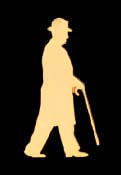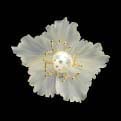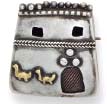Read My Pins (17 page)
Authors: Madeleine Albright

U.S. DEPARTMENT OF STATE
Interceptor Missile, Lisa Vershbow.

Sorcerer, Z. Alandia; other designers unknown.

UFO, Jonette Jewelry.

Bug, Iradj Moini.
The incident attracted unwelcome publicity, but the Russians learned nothing from their eavesdropping that we wouldn’t have told them if asked. Nor did the episode disrupt our diplomatic relations with Moscow, which have survived far more embarrassing cases of espionage. I met with Foreign Minister Ivanov in Europe only a few days subsequent to Gusev’s arrest. We greeted each other as the friends we were, but Ivanov could not fail to notice on my dress a pin in the shape of an enormous bug.

U.S. DEPARTMENT OF STATE
Perhaps it is my imagination, but this pin always seems to end the day higher on my jacket than where it began.
I was reminded while secretary of state that there is a political dimension to the operations of the gem industry. Valuable resources attract feverish competition for access and control. To regulate the market, the world has created a system that encourages trade based on agreed-upon standards and rules. In some cases, as with endangered species, those rules prohibit trade. In others, our leaders have found it necessary to limit or ban sales from particular countries. Two examples during my tenure are worthy of mention.
Jade has been called the stone of Heaven. It is a personal favorite of mine and has been sought after for centuries, initially by Chinese emperors and Asian warlords, more recently by lovers of fine gems on every continent. Carat for carat, jade’s value has soared. It is disquieting, then, that the majority of the world’s most precious jade (or, more properly, jadeite) is mined in Burma, home to some of the poorest people and one of the most repressive governments on Earth. Until the mid-1990s, ethnic groups controlled the mines, using the revenue to preserve autonomy from the military regime. Over the past decade, the government has seized control of the mines, exploiting them (and the beaten-down souls who labor in them) for money and power. While in office, I championed economic sanctions against Burma; these have since been extended to include the most lucrative types of Burmese gems that are processed elsewhere. The ban is
firmly supported by the Jewelers Vigilance Committee (a legal compliance group), the trade association Jewelers of America, and such leading international firms as Cartier and Tiffany.
In 1999, I visited a camp for amputees in Sierra Leone. It was a sweltering, muddy, crowded place. I remember especially holding a three-year-old girl who wore a red jumper and played with a toy car, using the only arm she had. Like many poor countries, Sierra Leone required voters to dip their fingers into indelible ink to prevent double-voting. The best-equipped rebel group felt it could frustrate the elections by chopping off the hands of potential voters, including children. This militia, and others in Angola and Congo, was financed in part by what came to be known as “blood” or “conflict” diamonds. These were diamonds seized and trafficked by armed groups that killed indiscriminately, often employing preteen soldiers.
Human rights activists appealed to me to try to stop the commercial use of such stones to fuel civil wars in Africa. I agreed. We supported a diplomatic initiative—known as the Kimberley Process—that is now accepted by every major diamond-producing and diamond-consuming country. Its purpose is to ensure that the much-coveted stones are traded legitimately from the time they leave a mine until the moment they appear in storefront windows. Like any such system, it is not leakproof, but it has done much to squeeze the profit out of blood diamonds, in part because the process has been widely backed by legitimate dealers. No responsible company wants to contribute to the success of thugs who start wars out of greed and hack off the limbs of children.
As a matter of policy, this story has an encouraging ending. On a personal level, it is even better. In 2007, I learned that the little girl in the red jumper whom I had tried to comfort in Sierra Leone had found adoptive parents and is now a happy and healthy teenager living on the same street as I do in Washington, D.C.

Panther, Cartier.

Trailing Eagle, Les Bernard.
“It Would Be an Honor”
The
twentieth of January 2001 was my final day as secretary of state. I imagined that the incoming staff might have to drag me out of my office by the heels, but in the end I went peacefully. I had had my time; now it was the turn of others. That is how democracy works.
In my new life, I have worn many hats—as author, professor, speaker, and businesswoman. I serve as chair of the National Democratic Institute and president of the Truman Scholarship Foundation and have led task forces on poverty, genocide, and Arab democracy. World affairs remain my preoccupation, which means I continue to crisscross the globe. I also enjoy, now more than ever, wearing and collecting pins.

COURTESY OF WILLIAM J. CLINTON PRESIDENTIAL LIBRARY/SHARON FARMER
I wore the Trailing Eagle pin for our official cabinet photo in 2000, my last full year as secretary of state.

This pen and book pin was a gift from my sister, Kathy Silva, upon the completion of my memoir,
Madam Secretary. Fountain pen, Carolee; book, designer unknown.
In Las Vegas years ago, I was booked to give a speech to a gathering of executives from the travel industry. The woman who organized the event asked what pin I intended to wear. I replied that I had brought only a necklace. She was aghast: “But that’s impossible; we all expect you to wear a pin.” Hours remained before the speech, and Las Vegas shops are always open, so I had little trouble finding something suitable. Since that time, I have learned to accept that when I appear in public, a pin is part of the package.
Fame, of course, is relative. In recent years, I have been mistaken in one venue or another for Margaret Thatcher, Barbara Bush, Judi Dench, Helen Thomas, some nice young fellow’s Aunt Agatha, and the television weather lady in Minneapolis. Confusing my face with that of someone else is—in my ledger—a misdemeanor. Ignorance of my pins, however, is a felony. Among former foreign ministers, one of my closest friends is Joschka Fischer of Germany. After I left office, I was interviewed with Joschka on Berlin television. The commentator asked him what he thought of my practice of using pins to send a diplomatic message. Fischer hadn’t a clue. He looked at me, then at her, then back at me, and confessed he couldn’t have an opinion about something he had never noticed. No doubt Joschka will be delighted this Christmas to find under his
Weihnachtsbaum
an autographed copy of this book.

Gift from the Harry S. Truman Presidential Library.

The 2008 election was one of the most exciting in memory. I was honored during the campaign to spend time working on foreign policy with the winner, President Barack Obama.
JIM BOURG/REUTERS

Flower with pearl, Russell Trusso.
JIM BOURG/REUTERS

Obama pins, Ann Hand.

Kangaroos and hippo (with friend), St. John Knits.

Desert village. The golden palm tree is from Saudi Arabia, the dwellings are from Egypt.

Palm tree, WRA;

desert dwellings, Arabic markings.
Early in my life, my mother’s ring served as a means for connecting one generation to another. When I was a young woman, the gift of a fraternity pin was an emblem of romance. In maturity, the brooches I bought for myself were signs of growing confidence and independence. In government, I used pins as a diplomatic tool. Now that I am out of office, my hobby often serves as an icebreaker. Before or after a speech, or while standing in line at the airport or supermarket, I am frequently asked about the pin I am wearing or to comment on one worn by somebody else. Such conversations, once initiated, can lead anywhere. I will not forget the woman who spoke enthusiastically about my pins before proceeding cheerily to compliment my overall appearance. “You look great,” she said. “Just like my grandmother. She’s 106 and as fit and sharp as she can be.”
Although I remain busy, I do have more time than previously to shop in Washington and around the United States. I also often pick up pieces while overseas. In a less troubled world, we would
ordinarily think of jewelry as sending a friendly message, or at least not a violent one. In the post-9/11 era, however, even bottles of mouthwash and tubes of toothpaste can be considered threats. Perhaps I should not have been surprised, then, when a security agent stopped me at an airport gate and asked to examine a brooch I had just purchased in Turkey. The pin is of a slithery dragon wrapped around a small silver sword. Nothing to worry about, except that the sword is removable. The security agent glanced at me, then peered at the pin while shaking his head. “No weapons,” he said.